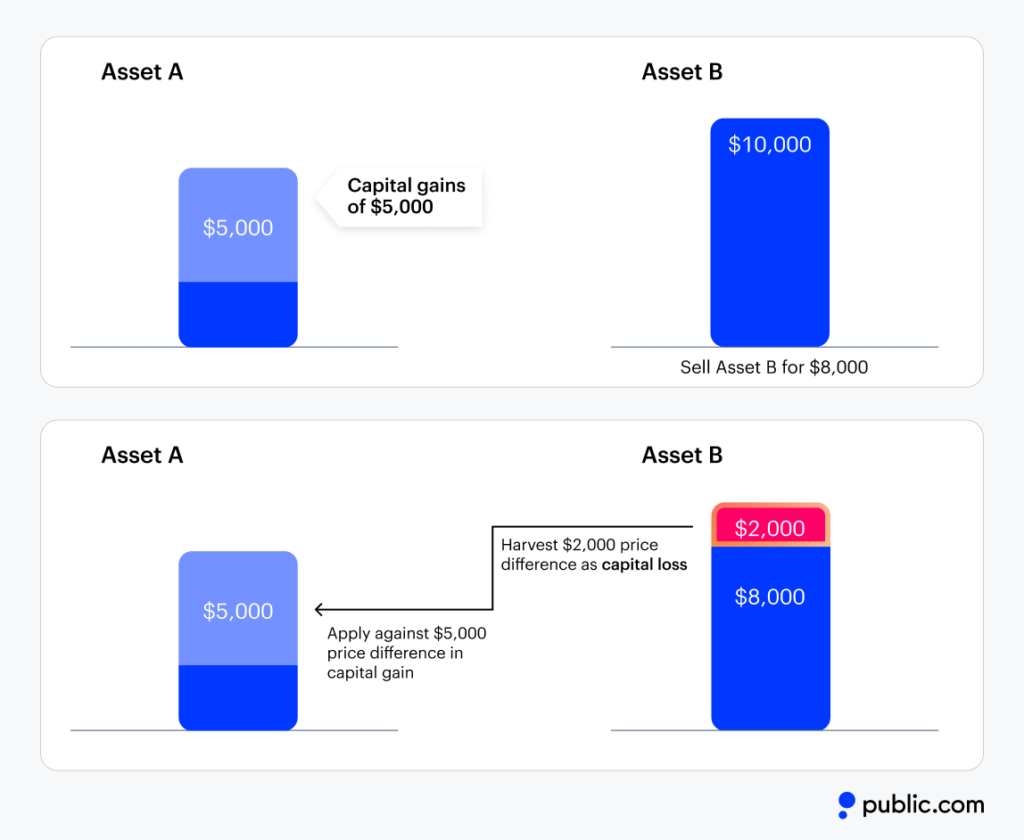Tax-loss harvesting is an investment strategy to reduce capital gains taxes. Here’s how it works: when an investment loses value, investors sell it. They then use the loss to offset their capital gains tax. If taxpayers don’t have investment income, they can also use losses to offset taxes owed on ordinary income.
However, this strategy can’t be used on retirement plans such as 401(k) and IRAs, or other accounts where taxes are deferred. And remember— it’s best to seek investment advice from a financial advisor or tax professional when rebalancing and planning your portfolio.
How does tax-loss harvesting work?
Tax-loss harvesting involves selling an investment at a loss in order to reap tax benefits and lower taxes. This loss can be used to offset capital gains taxes on investments. You can use tax-loss harvesting on a variety of asset classes, including bonds, stocks, or shares in an exchange-traded fund. Your asset allocation doesn’t affect your ability to take advantage of tax-loss harvesting, but it may affect your strategy.
Tax loss harvesting example
Let’s say you have capital gains of $5,000 and own another asset that’s worth $10,000. If you sell the asset for $8,000, you could “harvest” the $2,000 price difference as a capital loss and apply it against your $5,000 in capital gains. Importantly, this is a tax deferral strategy, not a way to cancel out your tax bill.
While tax-loss harvesting can be done throughout the year, the most common time to do it is at year end. That’s because December 31 is the last day for tax-loss harvesting and some investors want to see how their investments perform before harvesting.
Tax-loss harvesting is complicated and may not be right for your situation. Many advisory services offer tax-loss harvesting services to their clients. Consider consulting a licensed tax professional to determine if this is the right strategy for you.
Capital gains and losses
You’ll pay taxes on stocks and other tradable assets when you sell them for a profit. The taxes you pay are called capital gains taxes. But what about when you sell an asset for a loss? Capital losses are realized when an investment is sold at a lower price than the one at which it was bought. Realized losses can offset capital gains taxes and also can help rebalance your portfolio.
Gains and losses can be short or long-term and are taxed at the capital gains tax rate. Short-term capital gains are taxed at regular income rates, which are currently between 10% and 37% depending on your tax bracket. Long-term capital gains are taxed at rates of 0%, 15%, or 20%, depending on your individual tax situation. Losses on your investments are first used to offset capital gains of the same type. So, short-term losses are first deducted against short-term gains, and long-term losses are deducted against long-term gains. Net losses of either type can then be deducted against the other kind of gain.
2022 long-term capital gains rates
Some investors use tax-loss harvesting to replace one investment sold at a loss by reinvesting in a similar one. However, when implementing this strategy, it’s important to consider wash sales rules, as described below.
Tax-loss harvesting rules
While tax-loss harvesting is permitted by the IRS, there are a host of rules and requirements surrounding the procedure. Therefore, most tax experts recommend consulting with a professional before implementing tax-loss harvesting in your brokerage account.
Wash sale rule
The wash sale rule applies to any asset sold at a loss and replaced with an identical asset within 30 days of the sale. If, for example, you sell a stock and then rebuy the same stock in less than a month, it’s considered a wash sale. A transaction considered a wash sale cannot be used to offset capital gains. Some investors use exchange-traded funds (ETFs) when tax-loss harvesting to attempt to avoid wash sales.
Cost-basis calculations
The cost basis is the amount of money used to purchase an asset. You (generally with help from your broker) will be expected to keep records of your purchases to determine the appropriate cost basis when you report taxable income to the IRS on your tax return.
Crypto tax-loss harvesting
Since crypto is treated as a capital asset (like real estate or stocks), you can implement crypto tax-loss harvesting to offset these losses. This can be used against any capital asset, even if it isn’t cryptocurrency or an alternative investment. However, as is the case with other capital assets, you can only realize crypto gains or losses if you sell the currency you hold.
Limitations of tax-loss harvesting
While tax-loss harvesting may be beneficial for some tax situations, it comes with limitations too.
- Limits on the amount of capital losses in a year. If your tax status is single or married and filing jointly, the IRS allows up to $3,000 of capital losses each year. If you’re married and filing separately, the IRS allows up to $1,500 each year. Any loss left over can be applied against taxes in future years.
- Administrative costs associated with transactions. Some investors can only harvest a loss if the return exceeds administrative costs.
- Wash sales. Assets replaced with identical assets within 30 days of a sale are ineligible for capital gains offsetting.
Tax loss harvesting can be an effective strategy for reducing your tax bill, but it is worthwhile to also check Alternative Minimum Tax (AMT) before implementing this strategy.
Bottom line
Tax-loss harvesting can be tax-efficient, but it can also be risky. Whether you use an online brokerage or consult with a tax advisor for investment advice, it’s important to understand how different strategies can impact your personal finance strategy. With Public, you can get access to a community of fellow investors who can offer advice and suggestions to help you on your financial planning journey.

